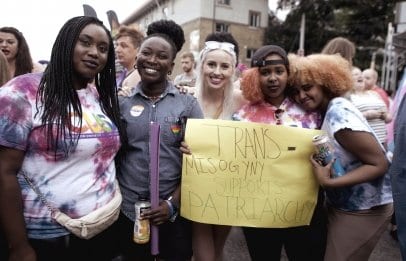
There was something special in the air on June 26, 2015 as the Trans* March made its way down Yonge Street.
It could have been the fact that same-sex marriage was finally legalized in the United States on the same day.
It could have been that the Ontario government announced, via an article in The Globe and Mail, that they are expanding access to sex-reassignment surgery for trans people.
Or it could have been that on an almost perfect June evening, over a thousand people gathered to march for trans rights; to be heard. And people came en masse to cheer them on.
“Love is love,” the celebratory chant embraced by American activists after the day’s historic US Supreme Court ruling on marriage equality, was often heard during the parade — at one point, shouted by onlookers who drowned out the chants of anti-gay protesters stationed at Church and Wellesley Streets.
But while the march celebrated a year of many significant gains for the trans community in Ontario, it was also a call to arms for activists and allies, to remind them of the work that is still left to do.
Solange Musanganya came from Montreal for the parade for the second year in a row. She says she comes for trans visibility and to represent her brothers and sisters in Africa who cannot safely march in any sort of Pride event.
“We want to show that we are like regular people,” she says.

Before the march started, a small group gathered by the trans memorial in Barbara Hall Park to honour those passed. Though the park sometimes feels more like a nightclub during Pride — it is the home of the Green Space dance parties — according to Nicki Ward, it wasn’t at all inappropriate.
“Let’s face it — many of the people who died would have enjoyed the music here,” Ward says, noting that though it is a memorial, it is not meant to be solemn.
At the intersection of College and Yonge Streets, activists staged a die-in, a grim reminder of how many trans people have died preventable deaths.
“These are for the deaths that go nameless; the graves that go nameless,” said Solomon Christiansen through a megaphone to the crowd.
Liam Carter carried a sign in the march naming some of the trans people who have died. “I’ve put this together just to show the number of people that have lost their lives to transphobic violence.”

“I identify as a trans male so it’s very important to me to have that visibility,” he says. “My life exists, and other people’s lives exist, and especially for this sign, that their lives existed.”
As the march ended at Yonge Dundas Square, a small group of drummers and dancers stayed on the street while police tried to move them toward the sidewalk as traffic resumed.
Photos by Becca Lemire


 Why you can trust Xtra
Why you can trust Xtra


